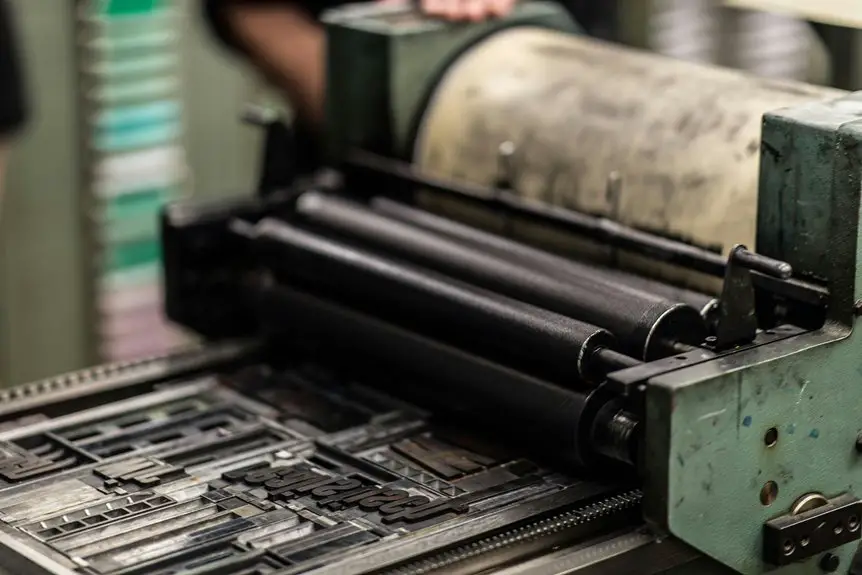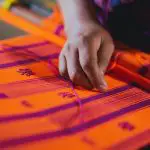You can use fabric ink on polypropylene, but it won’t stick well without preparation due to the material’s smooth, non-absorbent surface. To get good results, clean and lightly sand the surface, then apply a primer made for plastics. Solvent-based or specialty inks like plastisol work better than regular fabric inks. You can also try screen printing with the right settings or heat transfer methods for intricate designs. Keep going to discover how to make your prints last longer and look great.
Table of Contents
Key Takeaways
- Standard fabric inks often fail on polypropylene due to its low surface energy and non-absorbent texture, requiring special preparation or ink types.
- Solvent-based, plastisol, UV-curable, or epoxy inks offer better adhesion and durability on polypropylene than typical water-based fabric inks.
- Surface preparation, including thorough cleaning, light sanding, and applying a plastic primer, significantly improves ink bonding on polypropylene.
- Screen printing with lower mesh counts and solvent-based inks or heat transfer vinyl with controlled heat press settings are effective printing methods on polypropylene.
- Proper curing, thin ink layers, and post-print care enhance print durability and prevent smudging, peeling, or fading on polypropylene surfaces.
Understanding Polypropylene as a Material
Although polypropylene mightn’t be as familiar as cotton or polyester, you’ll find it in many everyday products due to its durability and resistance to chemicals and moisture.
Polypropylene is less familiar than cotton or polyester but widely used for its durability and chemical resistance.
When you handle polypropylene, you’ll notice it’s lightweight yet tough, making it ideal for reusable bags, outdoor gear, and packaging.
This thermoplastic polymer resists stains and doesn’t absorb water, which keeps it looking fresh and clean longer.
If you’re working with it, remember polypropylene’s low surface energy can make it tricky to adhere ink or paint to without proper preparation.
Its smooth, non-porous surface means typical fabric inks mightn’t bond well unless you use specific techniques or additives designed for synthetic materials.
Understanding these traits helps you choose the best method for decorating polypropylene successfully.
Characteristics of Fabric Ink
You’ll want to understand what makes up fabric ink and how it behaves on polypropylene.
Pay attention to how quickly it dries and how well it sticks to the material.
Also, consider how durable the ink remains after washing and regular use.
Ink Composition Overview
Understanding the composition of fabric ink is essential when working with polypropylene, as its unique properties demand specific ink characteristics. Fabric inks typically consist of pigments or dyes, binders, and solvents that work together to guarantee color vibrancy and durability on various textiles. Since polypropylene is a non-porous surface, the ink’s formulation must be compatible to achieve proper adhesion and flexibility without cracking.
| Component | Purpose | Common Materials |
|---|---|---|
| Pigments | Provide color | Organic/Inorganic dyes |
| Binders | Guarantee adhesion & durability | Acrylic, polyurethane |
| Solvents | Control ink flow & drying | Water, alcohols |
Drying and Adhesion
The composition of fabric ink directly affects how it dries and adheres to polypropylene surfaces.
Since polypropylene is non-porous and chemically inert, the ink’s drying time can vary considerably. You’ll notice that solvent-based inks tend to dry faster because the solvents evaporate quickly, allowing the ink to bond more effectively.
Water-based inks, however, may take longer and mightn’t adhere as well without a proper primer or surface treatment. To improve adhesion, you can lightly scuff the polypropylene or use a compatible bonding agent before applying the ink.
Also, curing the ink with heat or UV light can enhance its attachment. Understanding these factors helps you achieve a smooth, long-lasting finish on polypropylene materials.
Durability on Fabrics
Durability on fabrics depends largely on the ink’s formulation and how it interacts with different textile fibers. When you choose fabric ink, consider how well it withstands washing, sunlight, and wear. Some inks bond tightly with natural fibers like cotton but struggle with synthetics such as polypropylene. Understanding these differences helps you select the right ink for your project, ensuring long-lasting prints.
| Fabric Type | Ink Compatibility | Durability Level |
|---|---|---|
| Cotton | High | Excellent |
| Polyester | Medium | Moderate |
| Polypropylene | Low | Poor |
| Nylon | Medium | Moderate |
| Linen | High | Excellent |
This table shows you that durability varies, so pick inks suited for your fabric to maintain vibrant designs.
Challenges of Using Fabric Ink on Polypropylene
You’ll notice that getting fabric ink to stick well on polypropylene can be tricky because of its smooth surface and unique texture.
This affects not only how the ink adheres but also how durable and flexible the design remains over time.
Understanding these challenges is key to achieving the best results.
Ink Adhesion Difficulties
Although polypropylene offers excellent durability and resistance, it poses significant challenges when you try to get fabric ink to stick properly. Its non-porous, smooth surface repels most inks, making adhesion tough. You’ll quickly notice that the ink can smudge, peel, or fade after minimal wear.
Here are common ink adhesion difficulties you’ll face with polypropylene:
- Ink smears easily because it doesn’t absorb ink like cotton or polyester.
- Peeling and flaking occur as the ink sits on the surface without bonding.
- Poor durability leads to fading after washing or exposure to friction.
- Incompatibility with standard fabric inks means you often need special primers or coatings.
Understanding these challenges helps you select better inks or treatments for lasting prints on polypropylene.
Surface Texture Effects
Since polypropylene has a smooth and non-porous surface, its texture greatly affects how fabric ink adheres and performs.
When you apply ink, the lack of texture means there’s less grip for the ink to hold onto, causing it to sit on the surface rather than soak in. This can lead to smudging or uneven coverage.
If the polypropylene has any slight texture or embossing, it might help the ink latch on better, but smooth areas remain tricky. You’ll notice that ink may pool or bead up, making detailed designs harder to achieve.
To improve results, you might need to prepare the surface by lightly roughening it or using a primer designed for polypropylene before printing with fabric ink.
Durability and Flexibility
The smooth surface and limited grip of polypropylene not only affect ink adhesion but also challenge the durability and flexibility of your fabric ink designs.
Since polypropylene is less porous and more rigid than natural fabrics, your ink might crack, peel, or fade when bent or stretched.
To keep your designs intact, consider these points:
- Use flexible, specially formulated inks designed for synthetic materials.
- Avoid excessive stretching or bending of the printed area.
- Apply a protective coating or sealant to enhance durability.
- Test your prints under real-life conditions to spot weaknesses early.
Preparing Polypropylene Surfaces for Printing
To achieve vibrant and lasting prints on polypropylene, you need to properly prepare its surface before applying fabric ink.
Start by thoroughly cleaning the polypropylene to remove dust, oils, or residues that could prevent ink adhesion. Use isopropyl alcohol or a mild detergent solution, then let it dry completely.
Next, lightly roughen the surface with fine-grit sandpaper or a scuff pad to create texture for better ink grip. Be careful not to damage the material.
After sanding, clean off any dust with a lint-free cloth.
Finally, consider using a primer designed for plastics; this step boosts the ink’s ability to bond with polypropylene.
Taking these preparation steps guarantees your fabric ink will adhere well and produce sharp, durable prints on polypropylene surfaces.
Alternative Inks Suitable for Polypropylene
Although fabric inks are popular for printing on polypropylene, you might find that alternative inks offer better adhesion and durability for your projects.
While fabric inks are common, alternative inks often provide superior adhesion and durability on polypropylene surfaces.
Polypropylene’s smooth, non-porous surface can be tricky, so selecting the right ink is essential. Here are some alternatives you should consider:
- Solvent-based inks: These penetrate the surface better and provide long-lasting prints.
- UV-curable inks: They cure instantly under UV light, making them very durable.
- Epoxy inks: Known for strong adhesion and resistance to wear.
- Acrylic inks: Flexible and good for detailed designs, though they may require a primer.
Choosing the right ink depends on your project’s requirements and the desired finish.
Testing each option can help you achieve the best results on polypropylene.
Screen Printing Techniques for Polypropylene
Mastering three key screen printing techniques can greatly improve your results on polypropylene.
First, use a mesh screen with a lower mesh count (around 110-160) to allow thicker ink deposits, which adhere better to polypropylene’s non-porous surface.
Second, choose plastisol or specially formulated solvent-based inks designed for synthetic materials; these inks bond strongly and resist peeling.
Third, apply firm, even pressure with a sharp squeegee to push the ink thoroughly through the mesh and onto the substrate.
Make sure to clean your screens promptly after printing to avoid clogging.
Also, avoid excessive ink layers as polypropylene doesn’t absorb ink like natural fibers.
Heat Transfer Methods on Polypropylene
Screen printing delivers vibrant and durable results on polypropylene, but heat transfer methods offer a flexible alternative worth exploring.
When you use heat transfer on polypropylene, you apply a printed design onto the surface using heat and pressure, which helps the ink adhere properly. It’s especially useful for small runs or intricate designs.
To get started, consider these points:
- Choose heat transfer vinyl (HTV) designed for synthetic fabrics.
- Use a heat press with adjustable temperature and pressure settings.
- Preheat the polypropylene surface to improve adhesion.
- Avoid excessive heat to prevent warping or melting the material.
Tips for Achieving Durable Prints on Polypropylene
When you want your prints on polypropylene to last, focusing on proper preparation and curing is key.
Start by thoroughly cleaning the surface to remove dust, oils, or residues; this helps the ink adhere better. Use a primer designed for polypropylene to improve ink bonding. Choose inks formulated for plastics, like solvent-based or UV-curable inks, for stronger durability.
Apply thin, even layers to prevent cracking or peeling. After printing, cure the ink according to manufacturer instructions—usually with heat or UV light—to set the print firmly.
Avoid bending or stretching the material immediately after printing to prevent damage. Finally, test your prints under expected conditions, such as washing or exposure to sunlight, to make certain they hold up well over time.
Frequently Asked Questions
How Does Fabric Ink Affect the Recyclability of Polypropylene?
About 90% of polypropylene is recyclable, but when you use fabric ink, it can contaminate the material. You might reduce its recyclability because inks can interfere with the melting and reprocessing during recycling.
Can Fabric Ink on Polypropylene Withstand Outdoor Weather Conditions?
You can expect fabric ink on polypropylene to fade or peel under harsh outdoor conditions since polypropylene resists ink absorption. For better durability, consider inks specifically designed for synthetic materials and outdoor exposure.
What Are the Environmental Impacts of Using Fabric Ink on Polypropylene?
You should know that using fabric ink on polypropylene can release harmful chemicals during production and disposal. Choosing eco-friendly inks and recycling polypropylene helps reduce environmental impact, so you’re making a greener choice.
Are There Any Health Risks Associated With Fabric Ink on Polypropylene?
Worried about health risks? You shouldn’t be overly concerned, but some fabric inks contain chemicals that might irritate your skin or cause allergic reactions. Always use inks labeled non-toxic and guarantee proper ventilation when printing.
Can Fabric Ink Be Used on Colored Versus Clear Polypropylene Differently?
You can use fabric ink on both colored and clear polypropylene, but colors may affect ink visibility and vibrancy. On clear polypropylene, ink appears more translucent, so you might need multiple layers for better coverage and brightness.
- Tetron Fabric for Marine Applications: Durability and Use Cases - June 18, 2025
- Tetron Fabric for Outdoor Furniture: Weather Resistance and Care - June 18, 2025
- Tetron Fabric for Wall Coverings: Style and Application Tips - June 18, 2025






